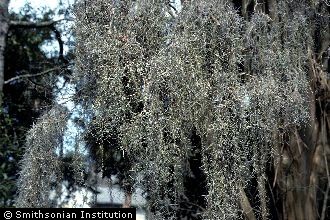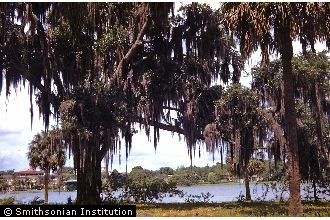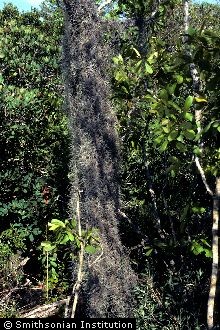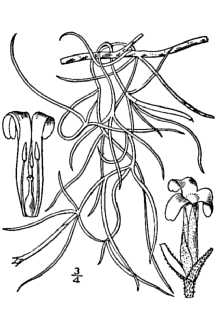Renealmia usneoides L.
Scientific Name: Renealmia usneoides L.

| General Information | |
|---|---|
| Usda Symbol | REUS |
| Group | Monocot |
| Life Cycle | Perennial |
| Growth Habits | Forb/herbVine, |
| Native Locations | REUS |
Plant Guide
Alternate Names
Graybeard, long moss, air-plant, Florida moss, con rape moss, wool crape, old man’s beard, grandfather’s whiskers
Uses
Ethnobotanic: Various Native American tribes, including the Houma and the Seminole, have used Spanish moss for a variety of purposes. When the outer coating of the plant is cleaned away, tough, black, curly inner fibers are exposed. These strong fibers were useful in many ways. The fibers were woven into a course cloth that was used for bedding, floor mats and horse blankets. The fibers could be twisted into cordage that was used as rope. The ropes were used to lash together the poles that composed the framework of housing. The dried fibers were used to remove scum in cooking. The process used to strip off the outer coating is still used today. It consists of placing bundles of the green moss into a shallow pond for six weeks, long enough for the outer coat to rot away. Dry Spanish moss was used for fire arrows. The moss was wrapped around the base of the shaft, lit on fire and then shot from the bow. The moss was also an ingredient in the clay that was used to plaster the insides of houses. Fresh Spanish moss was gathered, soaked in water and stuffed into dugout canoes to keep them from drying out and splitting. The Natchez tribe of Louisiana played a game that used fist-size balls that were stuffed with Spanish moss. The plant was boiled to make a tea for chills and fever. There is evidence that Spanish moss was used over 3,000 years ago to make fire-tempered pottery. Although the moss burned away during the firing, the distinctive pattern of the fibers is still evident in the clay pottery. Spanish moss is still used today by many Native American tribes. For example, the Houma and the Koasati use Spanish moss in the construction and decoration of small dolls. © J.R. Manhart @ Texas A&M University Wildlife: Several species of bats including the Seminole bat roost in clumps of Spanish moss. Yellow-throated warblers and northern parulas build their nests inside clumps of living Spanish moss. Several other species of birds gather the moss for nesting material. There is at least one species of spider that only occurs in Spanish moss. Livestock: The plant is used as fodder for animals. Other: Spanish moss is used in flower arrangements and as decorations for handicrafts. It is said to be excellent mulch for the garden. Spanish moss is grown commercially for use as packing material and as a replacement for horsehair in upholstery and mattress stuffing. Campers, because of red bugs and chiggers do not recommend the plants for use as bedding. If you wish to use fresh Spanish moss you may get rid of these pests by boiling small portions of the plant in water or heating them in the microwave.
Status
Please consult the PLANTS Web site and your State Department of Natural Resources for this plant’s current status (e.g. threatened or endangered species, state noxious status, and wetland indicator values).
Description
General: Pineapple Family (Bromeliaceae). Spanish moss is a native, perennial epiphytic herb. It is not Spanish, nor a moss, but a flowering plant. The slender, wiry, long, branching stems (reaching 8m or more) grow as suspended, bluish-gray streamers and garlands draping among tree branches and sometimes telephone lines and fences. The plant and is not parasitic, as is often thought, but attaches itself to trees for support. The plant has no roots but derives its nutrients from rainfall, detritus and airborne dust. The stems and leaves are covered with overlapping silver-gray scales, which are important for absorbing water and trapping dust and nutrient particles. It is thought that these plants may play a critical role in nutrient cycling. The very narrow, linear, awl-shaped leaves (2.5 to 8 cm long) are whitish gray. Numerous, small, solitary blue or pale green flowers with three petals (6 to 8 mm long) grow in the axils of the leaves. The flowers, which bloom for a period of three to four months from spring to fall, form interesting seeds (2.4 to 3 mm) with hairy sails that float on the wind and stick to tree branches. Distribution: Spanish moss is native to the Southeastern United States and Tropical America. For current distribution, please consult the Plant Profile page for this species on the PLANTS Web site. Habitat: Spanish moss grows on trees in areas of high humidity. It can be found on live oak and pines that border estuaries, rivers, swamps, and along the coastal plains of the Southeastern United States.
Establishment
Spanish moss may be propagated by seed or by division. The plants are very easy to grow, as they need no soil or transplanting, requiring only warmth and moisture. They are grown in greenhouses or outside in warm climates. The plants need temperature of 70 degrees or warmer in the summer and not less than 60 degrees in the winter. The plants grow well in full sunlight to partial shade. To propagate by division, place divided plantlets on bark slabs in areas with plenty of light and moisture. Mist plants regularly with lukewarm water. Spanish moss rarely blooms in cultivation.
Management
Although Spanish moss does not take nutrients from the host tree, it should be thinned if it becomes too thick. This is because it may either shade the tree’s leaves or, when it is wet it can become very heavy and the branches may break under its weight. Cultivars, Improved and Selected Materials (and area of origin) These plant materials are somewhat available from commercial sources. Contact your local Natural Resources Conservation Service (formerly Soil Conservation Service) office for more information. Look in the phone book under ”United States Government.” The Natural Resources
Conservation
Service will be listed under the subheading “Department of Agriculture.”
References
Bailey, L,H, & E,Z, Bailey 1976, Hortus Third: A concise dictionary of plants cultivated in the United States and Canada, Simon and Schuster Macmillan Co,, New York, New York, 1290 pp, Barbour, M,G,, & W,D, Billings, Editors 2000, North American terrestrial vegetation, Second Edition, Cambridge University Press, Cambridge, United Kingdom, 708 pp, Brown, R,C, 1994, Florida’s first people: 12,000 years of human history, Pineapple Press, Inc,, Sarasota, Florida, 262 pp, Chapman, A,W, 1883, Flora of the Southern United States: Flowering Plants and Ferns, Second Edition, J, Wilson and Son, Cambridge, Massachusetts, 698 pp, Columbia State University 1999, Spanish moss, [Online], Available: http://oxbow,colstate,edu/moss,htm, (20 June 2001), Duncan, W,H, & L,E, Foote 1975, Wildflowers of the Southeastern United States, University of Georgia Press, Athens, Georgia, 296 pp, Floridata,com, L,C, 1999, Plant profile: Tillandsia usenoides, [Online], Available: http://www,floridata,com/ref/t/till_usn,cfm, (20 June 2001), Greene, W,F, & H,L, Blomquist 1953, Flowers of the South: Native and Exotic, University of North Carolina Press, Chapel Hill, North Carolina, 208 pp, Kniffen, F,B,, H,F, Gregory, & G,A, Stokes 1994, The historic Indian Tribes of Louisiana, Louisiana State University Press, Baton Rouge, Louisiana, 324 pp, Lemke, C, Use soil moisture sensors to measure the soil moisture of Renealmia usneoides L.., 1999, Plant of the week: Tillandsia usneoides, Department of Botany and Microbiology,
Ethnobotany
Database: Foods, drugs, dyes and fibers of native North American Peoples. The University of Michigan-Dearborn. [Online]. Available: http://www.umd.umich.edu/cgi-bin/herb(19 June 2001) National Oceanic & Atmospheric Administraton. Spanish Moss. Ecological characterization of Otter Island, South Carolina. [Online]. Available: http://www.csc.noaa.gov/otter/htmls/data/species/moss.htm. (20 June 2001). Pacific Island ecosystems at risk (PIER). Invasive plant species. 2000. [Online]. Available: http://www.hear.org/pier/tiusn.htm. (20 June 2001). Small, J.K. 1933. Manual of Southeastern flora. University of North Carolina Press, Chapel Hill, North Carolina. 1554 pp. Smith, A.I. 1979. A guide to wildflowers of the Mid-south. Memphis State University Press, Memphis, Tennessee. 281 pp. Speck, F.G. 1941. A list of plant curatives obtained from the Houma Indians of Louisiana. Primitive Man Quarterly Bulletin of the Catholic Anthropological Conference 14(4): 49-75. Sturtevant, W.C. 1954. The Mikasuki Seminole: medical beliefs and practices. Doctoral Dissertation, Yale University. 538 pp. Wilson, H. 1998. Bromeliaceae-The pineapple family. IN Wilson, H. Taxonomy of flowering plants. Texas A&M University, College Station, TX. <http://www.csdl.tamu.edu/FLORA/Wilson/tfp/zin/bmlpage.htm>. Accessed: 27sep01.
Plant Traits
Growth Requirements
| Moisture Use | Medium |
|---|---|
| Adapted to Coarse Textured Soils | No |
| Adapted to Fine Textured Soils | No |
| Adapted to Medium Textured Soils | No |
| Anaerobic Tolerance | None |
| CaCO3 Tolerance | None |
| Cold Stratification Required | No |
| Drought Tolerance | None |
| Fertility Requirement | Low |
| Fire Tolerance | None |
| Frost Free Days, Minimum | 300 |
| Hedge Tolerance | None |
| pH, Maximum | 6.9 |
| pH, Minimum | 6.0 |
| Planting Density per Acre, Maxim | 7000 |
| Planting Density per Acre, Minim | 3450 |
| Precipitation, Maximum | 75 |
| Precipitation, Minimum | 40 |
| Root Depth, Minimum (inches) | 0 |
| Salinity Tolerance | None |
| Shade Tolerance | Tolerant |
| Temperature, Minimum (°F) | 22 |
Morphology/Physiology
| Bloat | None |
|---|---|
| Shape and Orientation | Irregular |
| Toxicity | None |
| Active Growth Period | Spring and Summer |
| C:N Ratio | Low |
| Coppice Potential | No |
| Fall Conspicuous | Yes |
| Fire Resistant | No |
| Flower Color | White |
| Flower Conspicuous | No |
| Foliage Color | White-Gray |
| Foliage Porosity Summer | Dense |
| Foliage Porosity Winter | Dense |
| Fruit/Seed Color | Black |
| Resprout Ability | No |
| Nitrogen Fixation | None |
| Low Growing Grass | No |
| Lifespan | Moderate |
| Leaf Retention | Yes |
| Known Allelopath | No |
| Growth Rate | Slow |
| Growth Form | Multiple Stem |
| Fruit/Seed Conspicuous | No |
| Foliage Texture | Fine |
Reproduction
| Vegetative Spread Rate | Moderate |
|---|---|
| Small Grain | No |
| Seedling Vigor | Medium |
| Fruit/Seed Period Begin | Fall |
| Seed Spread Rate | Moderate |
| Seed per Pound | 1200000 |
| Propagated by Tubers | No |
| Propagated by Sprigs | No |
| Propagated by Sod | No |
| Propagated by Seed | Yes |
| Propagated by Corm | No |
| Propagated by Container | No |
| Propagated by Bulb | No |
| Propagated by Bare Root | No |
| Fruit/Seed Persistence | No |
| Fruit/Seed Period End | Winter |
| Fruit/Seed Abundance | Low |
| Commercial Availability | No Known Source |
| Bloom Period | Late Summer |
| Propagated by Cuttings | Yes |
Suitability/Use
| Veneer Product | No |
|---|---|
| Pulpwood Product | No |
| Post Product | No |
| Palatable Human | No |
| Nursery Stock Product | No |
| Naval Store Product | No |
| Lumber Product | No |
| Fodder Product | No |
| Christmas Tree Product | No |
| Berry/Nut/Seed Product | No |



